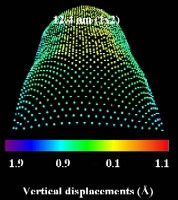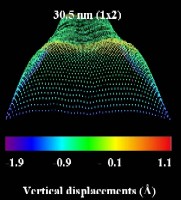Surface stress engineered spatially-selective and directed assembly of strain-driven epitaxical island quantum dots
We
are also the group to first combine the physics of the
two concepts noted above (i.e. critical deposition amount
for planar substrates and SESRE) to achieve purely growth-controlled
spatially-selective deposition of SAQDs on mesa tops
[86,87]. The lattice
mismatch induced stress magnitude is manipulated by
controlling the substrate structural pattern size and
shape in relation to the fundamental length scales of
the system: the typical range of stress field relaxation
near free surfaces and corners when mesas are created
[90,91]; the range of
lattice misfit induced stress fields as a function of
the size and shape of the islands; the impact of the
synergistically evolving stress fields once interactions
amongst these set in [91,92],
to note a few.
For
stripe mesas, we demonstrated [86] controlled number
of rows of SAQD formation, for deposition amount less
than the critical value for deposition on planar substrates,
as a function of the width of the stripe (see AFM images
left). In this case the strain relief due to the mesa
width reduction is only in the width direction. The
molecular dynamics (MD) simulations results for strained
stripe mesas are shown below:



By
contrast, when the mesas are made nanoscale in both
lateral directions, such as for nearly square mesas,
the strain relief with reduction in mesa size can become
so much as to completely suppress the island-like morphology
and give a flat film-like morphology for the quantum
dot (see the TEM images left) [84,85].
Our stripe and square mesa
experiments bracket the range and scope of stress relaxation
engineering / manipulation within which one can realize
laterally and vertically ordered countable ensembles
of SAQDs.